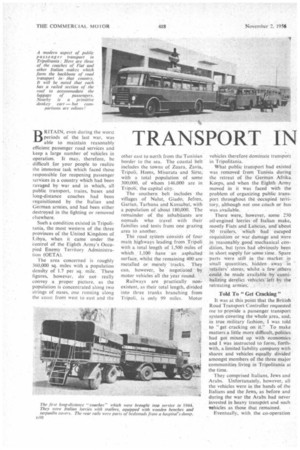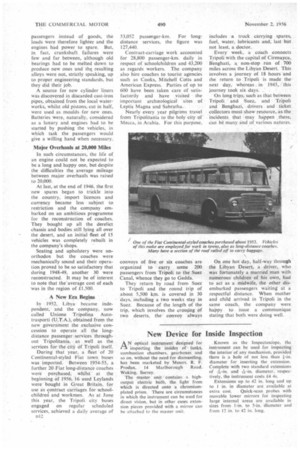TRANSPORT IN HE RAW
Page 50

Page 51

Page 52

If you've noticed an error in this article please click here to report it so we can fix it.
A Story of Remarkable Problems Faced While Recreating Public Passenger Transport in Libya: Only 250 Serviceable Vehicles Left by Retreating Germans By Count Cesare Dall'Aste Brandolini, A.I.R.T.E.
RITAIN, even during the worst periods of the last war, was • able to maintain reasonably efficient passenger road services and keep a large number of vehicles in operation. It may. therefore, be difficult for your people to realize the immense task which faced those responsible for reopening passenger services in a country which had been ravaged by war and in which, all public transport, trains, buses and long-distance coaches had been requisitioned by the Italian and German armies, and had been either destroyed in the fighting or removed elsewhere.
Such a condition existed in Tripolilania, the most western of the three provinces of the United Kingdom of Libya, when it came under the Control of the Eighth Army's Occupied Enemy Territory Administration (OETA).
The area concerned is roughly 360,000 sq. miles with a population denshy of 1.7 per sq. mile. These figures, however, do not really convey a proper picture, as the population is concentrated along two strings of oases, one running along the coast from west to east and the other east to north from the Tunisian border to the sea. The coastal belt includes the towns of Zuara, Zavia, Tripoli, Horns, Misurata and Sine, with a total population of some 300,000. of whom 146,000 are in Tripoli, the capital city.
The southern belt includes the villages of Nalut, Giado, Jefren, Garian. Tarhuna and Kussabat, with a population of about 180,000. The remainder of the inhabitants are nomads who travel with their families and tents from one grazing area to another.
The road system consists of four main highways leading from Tripoli with a total length of 1,500 miles of which 1,100 have • an asphalted surface, whilst the remaining 400 are metalled or merely tracks. They can, however, be negotiated by motor vehicles all the year round.
Railways are practically nonexistent, as their total length, divided into three trunks branching from Tripoli, is only 99 miles. Motor vehicles therefore dominate transpoi t in Tripolitania.
What public transport had existed was removed from Tunisia during the retreat of the German Afrika Korps, and when the Eighth Army moved in it was faced with the problem of organizing public transport throughout the -occupied territory, although not one coach or bus was available.
There were, however, some 250 oil-engined lorries of Italian make, mostly Fiats and Lancias, and about 50 trailers, 'which -had escaped requisition or war damage and were in reasmiably.good mechanical condition, but tyres had obviously been in-short supply for some time. Spare parts were still in the market in small quantities, hidden away in retailers' stores, whilst a few Others could be made available by cannibalizing derelict vehicles-left by the retreating armies: Told To "Get Cracking"
It was at this point that the British Road Transport Controller requested me to provide a passenger transport system covering the whole area, and, in true military fashion. I was told to "get cracking on it." To make matters a little more difficult, politics had got mixed up with economics and I was instructed to form, forthwith, a limited liability company with shares and vehicles equally divided amongst members of the three major communities living in Tripolitania at the time.
They comprised Italians, Jews and Arabs. Unfortunately, however, all the vehicles were in the hands of the Italians and the Jews, as before and during the war the Arabs had never invested in heavy transport and such vehicles as those that remained.
Eventually, with the co-operation of the authorities, this difficulty was overcome and the Nuova Compagnia Generale Auto!ince was born.
As a start, 36 lorries were equipped with wooden benches, covered with tarpaulins, issued with passenger-carrying licences and put on the road. Even this was not such an easy task as it might appear. The wood for the seats was scarce, the tarpaulins had to be made from Army tents and sacks, and the rails at the backs of the vehicles were produced by raiding the local hospital's dump of discarded bedsteads, but it was on the date that the " buses" began to operate that the real trouble began.
The roads, as a result of wartime wear and tear, were in very bad condition. The summer temperature averaged 90 degrees F. and quite often reached 115 degrees F. in the desert, consequently the alreadypoor tyres felt the strain.
New tyres could not be imported, no retread facilities existed and the frequent blow-outs had to be repaired by inserting gaiters into the old casings. Incidentally, these additions had to be secured by means of nuts and bolts.
No solution could, however, be found for the wear of the treads and every tyre had to be used until so many plies of the fabric had been worn through that-any small pebble on the road might cause a burst or puncture.
At this stage, hope of continuing operation had been almost lost, but then a rumour came to our ears. This was to the effect that a torpedoed ship, lying outside the harbour of Horns, had contained a load of tyres for the Italian Army, when she was sunk in October, 1942. Local fishermen volunteered to investigate the cargo and OETA gave permission for it to be salvaged, if possible. Thus 500 giant tyres became available and, amazingly enough, they were none the worse for their two years' immersion in the Mediterranean.
Meanwhile, the spares problem had obviously become acute and until the end of 1946, when at last the Italian factories were again able to produce spare parts, not an item entered the Territory. This meant that for four years, from January, 1943, to December, 1946, the company were compelled to live on their own resources—and this in a ravaged country under an occupying army.
I need not stress how long those four years seemed to me, as I was responsible for keeping the vehicles on the road, and the more so because they were the only existing means for public passenger transport, called upon to serve more than 400,000 people.
Little Private Transport
Among the civilian population there were only 25 private cars with licences in 1944, which rose to 140 in 1946, when the restrictions began to be eased.
Some of the sub-contractors owning the large vehicles had their own workshops but spares had to be made somewhere and it would have been far too expensive to experiment with what they might produce. The company were, therefore, compelled to set up a workshop of their own.
Road transport engineers for whom ample spares, machines and other equipment are available, would be astonished at what had to be done. Crankshafts, for which no substitutes could be found, were gradually ground down to far beyond the limits set by their makers; a 4 mm. reduction eventually became normal in all our engines.
Fortunately we were carrying passengers instead of goods, the loads were therefore lighter and the engines had power to spare. But, in fact, crankshaft failures were few and far between, although old bearings had to be melted down to produce new ones and the resulting alloys were not, strictly speaking, up to proper engineering standards, but they did their job.
A source for new cylinder liners was discovered in discarded cast-iron Pipes, obtained from the local waterworks, whilst old pistons, cut in half, were used as moulds for new ones. Batteries were, naturally. considered as a luxury and engines had to be started by pushing the vehicles, in which task the passengers would give a willing hand when necessary.
Major Overhauls at 20,000 Miles
In such circumstances, the life of an engine could not be expected to be a long and happy one, but despite the difficulties the average mileage between major overhauls was raised to 20,000.
At last, at the end of 1946. the first new spares began to trickle into the country, import licences and currency became less subject to restriction and the company embarked on an ambitious programme for the reconstruction of coaches. They bought up all the derelict chassis and bodies stilt lying all over the desert, and an initial fleet of 15 vehicles was completely rebuilt in the company's shops.
Seating and upholstery were unorthodox but the coaches were mechanically sound and their operation proved to be so satisfactory that during 1948-49, another 30 were reconstructed. It may be of interest to note that the average cost of each -was in the region of 11,500.
A New Era Begins In 1952, Libya became independent, and the company, now called Unione Tripolina Autotrasporti (U.T.A.), obtained from the new government the exclusive concession to operate all the longdistance passenger services throughout Tripolitania, as well as the services for the city of Tripoli itself.
During that year, a fleet of 20 Continental-styled Fiat town buses was imported. Between 1954-55, a further 20 Fiat long-distance coaches were purchased, whilst• at the beginning of 1956, 16 used LeyIands were bought in Great Britain, for use as contract carriages for schoolchildren and workmen. As at June this year, the Tripoli city buses engaged on regular scheduled services, achieved a daily average of o 12 53,052 passenger-km. For longdistance services, the figure was 127,440.
Contract-carriage work accounted for 28,800 passenger-km. daily in respect of schoolchildren and 43,200 as regards workers. The company also hire coaches to tourist agencies such as Cooks, Mitchell Cotts and American Express. Parties of up to 600 have been taken care of satisfactorily and have visited the important archaeological 'sites of Leptis Magna and Sabratha.
Nearly every year pilgrims travel from Tripolitania to the holy city of Mecca, in Arabia. For this purpose, convoys of five or six coaches are organized to carry some 200 passengers from Tripoli to the Suez Canal, whence they go to Gedda.
They return by road from Suez to Tripoli and the round trip of about 5,500 km. is covered in 30 days, including a two weeks stay in Suez. Because of the length of the trip, which involves the crossing of two deserts. thefl convoy always
includes a truck carrying spares, fuel, water, lubricants and, last but not least, a doctor.
Every week, a coach connects Tripoli with the capital of Cirenayca, Benghazi, a non-stop run of 700 miles across the Libyan Desert. This involves a journey of 18 hours and the return to Tripoli is made the next day, whereas in 1945, this journey took six days.
On long trips, such as that between Tripoli and Suez, and Tripoli and Benghazi, drivers and ticket collectors mustshow resource, as the incidents that may happen there, can be many and of various natures.
On one hot day, half-way through the Libyan Desert, a driver, who was fortunately a married man with numerous children of his own, had to act as a midwife, the other disembarked passengers waiting at a respectful distance. When mother and child arrived in Tripoli in the same coach. the company were happy to issue a communique stating that both were doing well.
















































































































